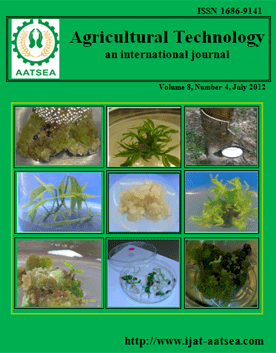ThaiScience
ThaiScience
INTERNATIONAL JOURNAL OF AGRICULTURAL TECHNOLOGY
Volume 14, No. 05, Month SEPTEMBER, Year 2018, Pages 621 - 630
Effect of protein content in feed formulas on growth and nutritional values of mealworms
Bumroongsook, S. and Nahuanong, P.
Abstract Download PDF
An experiment was designed to determine the effects of high dietary protein feeding on the growth and nutritional values of mealworms. The experiment was designed as completely randomized design with 5 treatments consisting of 5 feeding formulas mixed on weight basis: I) wheat bran II) broiler chicken feed + soybean meal (3:1) III) broiler chicken feed+ soybean meal (1:3) IV) broiler chicken feed+ soybean meal (1:1) and V) broiler chicken feed + soybean meal (1:1) and 10 replications. Mealworms (850 insects) aged 2 weeks were raised in a plastic box at room temperature(35-38 oC) with carrot as water supplement for 8 weeks. Average weight gain, length measurement and percentage mortality were calculated every week over feeding periods. On the eighth week, the results showed that the mealworms raised with the formula I and III had maximum weight of 0.15 g. Their body length of mealworms from formula I were the longest (2.70 cm) and no statistically different was found in mortality rate among treatments (p>0.05). The results indicated that high protein feed did not have effect on weight and body length of mealworms. The cost of 5 feeding formulas in rearing 850 mealworms for 8 weeks was as follows :2.52, 3.91, 4.13, 4.02 and 4.00 $, respectively. The studies indicated that the mealworms fed with formula I had gained maximum growth with minimum cost of production. An analysis of the chemical composition of the raw materials in feed formulas for mealworms indicated that soybean meal had highest protein content, following by soybean, broiler chicken feed, rice bran and carrot 48.82, 39.35, 21.18, 18.72 and 7.06%, respectively. Soybean had highest amount of fat, 20.14%. It was found that mealworms fed with formula IV had the highest protein of 54.89%. The mealworms raised from the formula I and II had the highest fat 29.54 and 29.88, respectively and highest energy found in mealworms from formua I, 6,193.22 cal/g. The pearson analysis showed a very strong positive relationship on protein and very weak positive correlation on fat in feed and in mealworms. In addition, the protein content in feed had no effect on mealworm growth.
Keywords
Proximate analysis, chemical composition, feeding formulasINTERNATIONAL JOURNAL OF AGRICULTURAL TECHNOLOGY
Published by : Association of Agricultural Technology in Southeast Asia (AATSEA)
Contributions welcome at : http://www.ijat-aatsea.com
